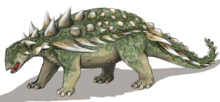多刺甲龙科
多刺甲龙亚科(学名:Polacanthinae),生存于侏罗纪晚期到白垩纪早期。多年来,其分类仍有争议,根据不同的研究人员,多刺甲龙亚科被归类于结节龙科或甲龙科,或是独立建立为多刺甲龙科(Polacanthidae)。
| 多刺甲龙亚科 | |
|---|---|

| |
无效状况
| |
| 科学分类 | |
| 界: | 动物界 Animalia |
| 门: | 脊索动物门 Chordata |
| 纲: | 蜥形纲 Sauropsida |
| 总目: | 恐龙总目 Dinosauria |
| 目: | †鸟臀目 Ornithischia |
| 科: | †结节龙科 Nodosauridae |
| 亚科: | †多刺甲龙亚科 Polacanthinae Wieland, 1911 |
| 属 | |
| 异名 | |
| |
叙述
编辑多刺甲龙亚科的化石发现于北美洲与欧洲,较常出现在北美洲。第一个发现的多刺甲龙亚科是林龙,在1832年发现于英国萨塞克斯的蒂尔盖特森林。在1865年,多刺甲龙发现于英国。在1898年,美国南达科他州发现了装甲龙的化石[1]。之后在北美洲发现了其他的多刺甲龙类化石,这些原始的恐龙,有助于了解甲龙类的演化。
多刺甲龙亚科生存于侏罗纪晚期到白垩纪早期,存在了将近3000万年。詹姆士·柯克兰(James Kirkland)提出,多刺甲龙亚科的存在时期,北美洲与亚洲之间有陆桥连接[2]。
多刺甲龙亚科缺乏甲龙科特有的尾槌,但背部的长刺可用来抵抗掠食动物。牠们与其他甲龙类的差异在于具有大片的荐部盾甲(位于荐骨上方),上有多排的瘤状物。
与结节龙科、甲龙科相比,多刺甲龙亚科的鳞甲较轻型。与结节龙科相比,牠们的背部尖刺较薄、较小型。研究人员推测,多刺甲龙类的鳞甲主要在视觉辨识功能,身体防护是次要功能[3]。
多刺甲龙亚科之中,体型最大的是林龙,身长可达6米;最小的是怪嘴龙与迈摩尔甲龙,身长2.7到3米,牠们同时也是最小的甲龙类恐龙之一。体重介于1到3公吨之间[4]。牠们可能是群居动物。
分类
编辑在1911年,George R. Wieland建立多刺甲龙科,以包含无法归类于甲龙科、结节龙科的甲龙类恐龙。
传统上,甲龙亚目可分为结节龙科与甲龙科。结节龙科具有狭窄的头部,缺乏尾槌,肩膀处有显目的大型尖刺;甲龙科的头部宽广,具有尾槌。多刺甲龙亚科同时具有结节龙科与甲龙科的特征,头部类似甲龙科,身体类似结节龙科。由于多刺甲龙亚科大多破碎,或头部骨头残缺不全,造成分类上的困难。
根据不同的研究人员,多刺甲龙亚科曾被归类于甲龙科。例如在1998年,詹姆士·柯克兰将其修改为多刺甲龙亚科,是甲龙科的一个亚科,包含:多刺甲龙、加斯顿龙、迈摩尔甲龙[5][6][7][8][9],或是结节龙科[10]。
在2001年,肯尼思·卡彭特(Kenneth Carpenter)在一个甲龙亚目的系统发生学研究中,再将多刺甲龙亚科修改为多刺甲龙科,亲缘关系较接近甲龙科,离结节龙科较远;并将多刺甲龙科定义为:包含所有接近加斯顿龙,而离埃德蒙顿甲龙、包头龙较远的所有物种。他认为这些甲龙类恐龙的身体构造相当特殊。甲板接近三角形,而且薄。甲板的排列与牙齿相当原始[11]。但有其他研究人员提出异议。
M. Vickaryous等人在2004年的研究,则将怪嘴龙与加斯顿龙列为原始的甲龙科,而其余四属则是甲龙亚目的未定属[12]。
许多近年研究将多刺甲龙亚科视为一群原始甲龙科恐龙,但大部分并没有经过详细研究证实。在2012年的一份多刺甲龙亚科详细研究,提出牠们不是原始甲龙科的并系群,也不是结节龙科的一个亚科[13]。
参考资料
编辑- ^ Lucas, F.A. (1901). A new dinosaur, Stegosaurus marshi, from the Lower Cretaceous of South Dakota. Proceedings of the United States National Museum 23(1224):591-592.
- ^ Kirkland, J. I. (1996). Biogeography of western North America's mid-Cretaceous faunas - losing European ties and the first great Asian-North American interchange. J. Vert. Paleontol. 16 (Suppl. to 3): 45A
- ^ Hayashi, S., Carpenter, K., Scheyer, T.M., Watabe, M. and Suzuki. D. (2010). "Function and evolution of ankylosaur dermal armor." Acta Palaeontologica Polonica, 55(2): 213-228. doi:10.4202/app.2009.0103
- ^ J. Peczkis. 1995. Implications of body-mass estimates for dinosaurs. Journal of Vertebrate Paleontology 14(4):520-533
- ^ K. Carpenter, J. I. Kirkland, C. Miles, K. Cloward, and D. Burge. 1996. Evolutionary significance of new ankylosaurs (Dinosauria) from the Upper Jurassic and Lower Cretaceous, Western Interior. Journal of Vertebrate Paleontology 16(3, suppl.):25A
- ^ K. Carpenter and J. I. Kirkland. 1998. Review of Lower and middle Cretaceous ankylosaurs from North America. Lower and Middle Cretaceous Terrestrial Ecosystems, S. G. Lucas, J. I. Kirkland & J. W. Estep (eds.). New Mexico Museum of Natural History and Science Bulletin 14:249-270
- ^ J. I. Kirkland. 1998. A polacanthine ankylosaur (Ornithischia: Dinosauria) from the Early Cretaceous (Barremian) of eastern Utah. Lower and Middle Cretaceous Terrestrial Ecosystems (S. G. Lucas, J. I. Kirkland, & J. W. Estep, eds.), New Mexico Museum of Natural History and Science Bulletin 14:271-281
- ^ K. Carpenter, J. I. Kirkland, D. Burge and J. Bird. 1999. Ankylosaurs (Dinosauria: Ornithischia) of the Cedar Mountain Formation, Utah, and their stratigraphic distribution. Vertebrate Paleontology in Utah, D. D. Gillette (ed.), Utah Geological Survey Miscellaneous Publication 99-1:243-251
- ^ W. T. Blows. 2001. Dermal armor of the polacanthine dinosaurs. In K. Carpenter (ed.), The Armored Dinosaurs. Indiana University Press, Bloomington 363-385
- ^ X. Pereda Suberbiola and P. M. Galton. 2001. Reappraisal of the nodosaurid ankylosaur Struthiosaurus austriacus Bunzel from the Upper Cretaceous Gosau Beds of Austria. In K. Carpenter (ed.), The Armored Dinosaurs. Indiana University Press, Bloomington 173-210
- ^ Carpenter K. Phylogenetic analysis of the Ankylosauria. Carpenter, Kenneth(ed) (编). The Armored Dinosaurs. Indiana University Press. 2001: 455–484. ISBN 0-253-33964-2.
- ^ Matthew K. Vickaryous, Teresa Maryańska und David B. Weishampel: Ankylosauria. In: David Weishampel, Peter Dodson und Halszka Osmólska (Hrsg.): The Dinosauria. University of California Press, 2004. ISBN 0520242092; S. 363-392.
- ^ Thompson, R.S., Parish, J.C., Maidment, S.C.R. and Barrett, P.M. (2012). "Phylogeny of the ankylosaurian dinosaurs (Ornithischia: Thyreophora)." Journal of Systematic Palaeontology, 10(2): 301-312. doi:10.1080/14772019.2011.569091